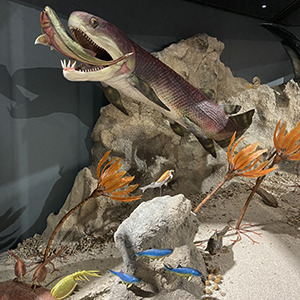Published 28 September 2022 at 19.50
Domestic. How animals that lived hundreds of millions of years ago were structured internally is something scientists mostly have to guess because entrails rot away. But in 380-million-year-old fossils from armored sharks, scientists have now found extremely well-preserved hearts, stomachs, livers and intestines.
Like the article på Facebook

© Curtin University
The armored shark Compagopiscis hunted around a tropical reef 380 million years ago. Here, however, it is itself eaten by the broom-fin Onychodus.
– Here we are at the time when the large groups of vertebrates arise and begin to develop in different directions, so it is enormously interesting to understand the anatomy of the vertebrates that lived then, says Per Ahlberg, professor at the Department of Organismal Biology, Uppsala University, and a by the researchers behind the study published in the scientific journal Science.
Something he and his research group have long been interested in is how it happened when the jaws developed, which resulted in changes in the location of the viscera. The first vertebrates appeared over 500 million years ago and had no jaws. They were so-called roundmouths like today's piranhas and neon eyes. Per Ahlberg calls the emergence of jaws the biggest step in the evolution of vertebrates. Because among today's vertebrates, almost all of them have jaws, including ourselves.
Using advanced synchrotron tomography and neutron tomography, he and his colleagues have now been able to study the well-preserved fossils found in northwestern Australia. The images they obtained show that the internal organs of armored sharks were positioned in the same way as in most of today's vertebrates.
– We have a real stomach. We see it here for the first time. We can see the walls of the stomach and the glandular structure in it. We can see the structure of the liver, that the heart is where it should be in a jawed fish – as well as in the pit of the neck well separated from the liver. So far, they confirm the character traits we see in all living jawed vertebrates, says Per Ahlberg.
The finds originate from the Devonian geological time period, which is also usually called the age of the fishes because these then undergo enormous development and diversification. Among other things, there is a division between bony fish that have a skeleton of bones, and cartilaginous fish that have a cartilaginous skeleton and today consist of sharks and rays. Unlike bony fish, cartilaginous fish lack lungs or a swim bladder. In order not to sink, they have to constantly swim and also have a very large liver that is filled with oil. The same seems to have applied to the armored sharks.
– We find no traces of lungs or swim bladder. And in addition, we find that the liver is quite large and could presumably have contained oil for a little extra buoyancy, says Per Ahlberg.
The fact that the bodies of armored sharks are preserved so alarmingly, even three-dimensionally, is due to the unusual phenomenon that fossilization probably started at the same moment the fish died. A possible explanation for that is that the deep water was oxygen-free all the way up to the sunlit zone.
– There seems to have been green sulfur bacteria in the water – they want the combination of sunlight but not oxygen – and that these in some shady way has affected the water chemistry and the chemistry inside dead fish that sink through the water column so that they begin to mineralize already on their way down to the bottom, says Per Ahlberg.